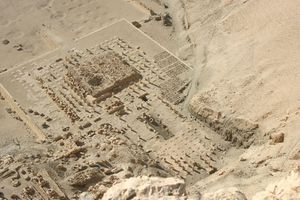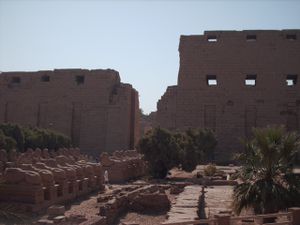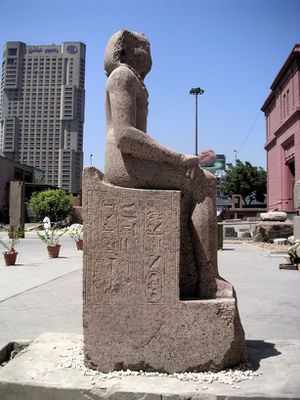What Are the Origins of Ancient Egypt’s Middle Kingdom
Today, Egypt’s Middle Kingdom (ca. 2055-1650 BC) is often overlooked in popular histories of ancient Egypt in favor of the Old and New Kingdoms. Even among scholars, the Middle Kingdom has been the subject of far fewer scholarly studies with most published works instead focusing on the high number of extant texts from the New Kingdom and Late Period or the many intact archaeological monuments of the Old Kingdom, such as the Great Pyramids. Although the kings of the Middle Kingdom did not produce pyramids on the scale or as enduring as those of the Old Kingdom and Egyptian imperial aspirations were only a fraction of that in the New Kingdom, the Middle Kingdom was no less important.
Middle Kingdom scribes were responsible for some of the best literary pieces ever produced in ancient Egypt, which were rewritten and reproduced during the New Kingdom and Late Period. The dialect of the ancient Egyptian language that was used in writing during the Middle Kingdom – Middle Egyptian – became the language of high Egyptian culture and was emulated for centuries after the fall of the kingdom. But even more important than the literary and linguistic advances that were made during the Middle Kingdom was the very fact that it even came into existence. After the collapse of the Old Kingdom around the year 2125 BC, Egyptian Civilization entered into a prolonged period of anarchy and decentralized rule. There is no reason why the situation could not have continued and if so today Egyptian Civilization would be remembered only for the Great Pyramids and little else, but instead a new dynasty formed in the southern city of Thebes that was able to assert control over the entire Nile Delta, unifying Egypt once more and ensuring that Egypt would be among the longest enduring civilizations in human history.
The First Intermediate Period
To an Egyptian living at the time the Great Pyramids were being built, it may have seemed like the civilization would have continued for eternity. The great monuments where the Egyptians interred their kings may have been eternal, but their government system was not and like all bureaucracies it had its problems. The problem in the Egyptian bureaucracy was that although it was quite efficient for some time, eventually regional leaders began to gradually usurp more power until there was no longer a centralized state, resulting in what Egyptologists refer to as the First Intermediate Period (ca. 2125-2055 BC). [1] The breakdown in central government is important when one considers that the ancient Egyptians saw their country and civilization as essentially two lands – Upper (southern) and Lower (northern) Egypt – joined into one. The concept of the Egyptian king as the unifier of the two lands was extremely important and expressed in their art, texts, and royal titulary with phrases such as, “he who unites the two lands.”
Unfortunately, along with the collapse of the central government, there was a lack of building activity, which means that very few archaeological evidence remains from the First Intermediate Period. Also, the ancient Egyptians were usually averse to writing about their own history in a negative manner, so there are few reliable primary texts from the period. Therefore, the third century Hellenized Egyptian priest and historian, Manetho, provides one of the only ancient historical accounts of the period. Most Egyptologists consider the Eighth Dynasty to be the final dynasty of the Old Kingdom, while the Ninth, Tenth, and part of the Eleventh dynasties comprised the First Intermediate Period. According to Manetho, the Ninth Dynasty was based in the city of Heracleopolis, which was located not far to the south from the former capital of Memphis.
“The Ninth Dynasty consisted of four kings of Heracleopolis, who reigned for 100 years. The first of these, King Achthôês, behaving more cruelly than his predecessors, wrought woes for the people of all Egypt, but afterwards he was smitten with madness, and was killed by a crocodile.” [2]
Manetho also stated that the Tenth Dynasty was based in Heracleopolis, but that the Eleventh Dynasty formed hundreds of miles to the south in Thebes/Diosopolis. [3] Despite being numbered in sequence, the Tenth and Eleventh dynasties existed simultaneously, but both sought to unify the country under their rule. Most modern scholars consider the Ninth and Tenth dynasties to be the same, which they base on the New Kingdom king-list known as the Turin Canon. [4] A number of battles took place around the halfway point between Heracleopolis and Thebes that would determine the future of Egypt for hundreds of years. [5]
Mentuhotep II
Mentuhotep II (ruled ca. 2055-2004 BC) continued the war that began during the rule of his predecessor, Inyotef, and brought it to a conclusion some time late in his reign. During the thirty-ninth year of his rule, Mentuhotep II took the Horus name (Egyptian kings would take up to five names), “Horus Sematawy,” which means “Horus the Unifier of the Two Lands,” indicating that he won the war against Heracleopolis around that time. [6] In later periods of Egyptian history, Mentuhotep II was celebrated as one of the greatest pharaohs, along with Menes/Narmer (reigned ca. 3100 BC), who was the first king of the unified Egyptian state, and Ahmose (ruled ca. 1552-1525 BC), who expelled the Hyksos from Egypt and ushered in the New Kingdom. The exact details of the conflict’s end remain a mystery for the most part. Other than to laud Mentuhotep II as a great king, the New Kingdom texts give few details. A tomb known as the “Tomb of the Warriors,” which was located not far from Mentuhotep II’s mortuary complex at Deir el-Bahri, gives some archaeological context to the war. The corpses seem to have all been ceremonially buried with their weapons as a show of respect for those who fought for the king to unify Egypt. [7] Once Mentuhotep II defeated Heracleopolis, he immediately set to work reorganizing the Egyptian state, giving it new vitality and the ability to expand beyond its natural borders.

The Creation of the Middle Kingdom State
Many of the reforms that Mentuhotep II did at the beginning of the Middle Kingdom were not very revolutionary, but were based on what worked during the Old Kingdom. Although the administrative system of the Old Kingdom became weak and corrupt, it was incredibly strong and efficient for hundreds of years. Because of that, Mentuhotep II chose the basic structure of the Old Kingdom bureaucracy to serve as a model for his vision of the state. He appointed a vizier as head of the administration and a treasurer was the next in line. A steward, who worked closely with the king, oversaw the state’s lands, which technically included all of the country, but more directly related to lands controlled by the temples. [8] With the Egyptian state running efficiently once more, Mentuhotep II was able to focus his energies beyond Egypt.
Although there is evidence of Egypt conducting military expeditions into Nubia and possibly the Levant during the Old Kingdom, it was during the Middle Kingdom when Egypt became a true imperial power by establishing forts in Nubia. Most of Egypt’s Middle Kingdom imperial activities took place during the Twelfth Dynasty, but the precedent was established by Mentuhotep II. Within five years of unifying Egypt, Mentuhotep II sent military expeditions past the first cataract of the Nile River into what was ancient Nubia, known to the Egyptians as Kush or Wawat. A brief hieroglyphic text commemorates Mentuhotep II’s expedition:
“Year 41, under (the majesty of Nebkhrure (Mentuhotep II), came the wearer of the royal seal, sole companion, chief treasurer, Kheti, born of Setre, triumphant; and ships to Wawat------” [9]
There is also evidence to suggest that Mentuhotep II led a military campaign into the Levant. [10] Although Mentuhotep II’s military activities were minor compared those in the New Kingdom, or even in the Twelfth Dynasty for that matter, his efforts were enough to spur later actions that helped to establish the precedent of Middle Kingdom Egypt as an ancient imperial power.
Related Articles
The End of the Eleventh Dynasty
The details of the end of the Eleventh Dynasty are still a mystery to modern scholars. The Turin Canon king-list does not mention the name of the dynasty’s final king, but does give a period of seven years, which would place his, or their, reign from about 1992-1985 BC. The name of a king named Mentuhotep IV is known from a few inscriptions, but it remains unknown if he filled the entire seven years before Amenemhat I (reigned 1985-1955) became the first king of the Twelfth Dynasty, or if he shared that short period with other kings. [11] The end of the Eleventh Dynasty is historically important when one considers that Egypt had just emerged from a civil war. If Mentuhotep II would not have brought stability back to the state, the Middle Kingdom could have collapsed before it really began. Instead, the state not only survived but prospered tremendously during the Twelfth Dynasty. One of the few texts associated with Mentuhotep IV is an account of a quarrying expedition led by a prince named Amenemhat, who is believed to be the same Amenemhat who became the first king of the Twelfth Dynasty.
“My majesty has sent the prince, mayor of the city, vizier, chief of royal works, royal favorite, Amenemhat, with a troop of ten-thousand men from the southern nomes of Upper Egypt, and from the [garrisons] of Thebes, in order to bring me a precious block of the pure stone of this mountain, whose excellence was made by Min, for the lord of life, who recalls eternity even more than the monuments in the temples of Upper Egypt, as a mission of the king who rules the Two Lands, so as to bring him his heart’s desire from the desert lands of his father Min. He made it as his monument to his father Min of Coptus, lord of desert lands, ruler of Bowmen, that he may give very many [jubilees] and to live like Re forever. [12]
Conclusion
The history of Middle Kingdom Egypt is often be overlooked today in favor of the Old and New Kingdoms, but it was just as important. It was created through conflict and civil war, culminating in the reunification of Egypt under Mentuhotep II. The many ideas, policies, and innovations that marked the Middle Kingdom and made it strong in the Twelfth Dynasty were the result of Mentuhotep II’s victory on the battlefield and foresight in terms of government policies and imperial ambition.
References
- Jump up ↑ Grajetzki, Wolfram. The Middle Kingdom of Ancient Egypt. (London: Duckworth, 20009), p. 7
- Jump up ↑ Manetho. Aegyptiaca. Translated by W. G. Waddell. (Cambridge, Massachusetts: Harvard University Press, 2004), Fr, 28a
- Jump up ↑ Manetho, Frgs., 29-32
- Jump up ↑ Kuhrt, Amélie. The Ancient Near East: c. 3000-330 BC. (London: Routledge, 2010), p. 156
- Jump up ↑ Grajetzki, p. 8
- Jump up ↑ Grajetzki, p. 19
- Jump up ↑ Callender, Gae. “The Middle Kingdom Renaissance (c. 2055-1650 BC).” In The Oxford History of Ancient Egypt. Edited by Isan Shaw. (Oxford: Oxford University Press, 2000), pgs. 150-1
- Jump up ↑ Grajetzki, p. 21
- Jump up ↑ Breasted, James Henry, ed. and trans. Ancient Records of Egypt. Volume 1: The First to the Seventeenth Dynasties. (Champaign, Illinois: Routledge, 2001), p. 156
- Jump up ↑ Grajetzki, p. 20
- Jump up ↑ Grajetzki, p. 25
- Jump up ↑ Lichtheim, Miriam, ed. and trans. Ancient Egyptian Literature. Volume 1: The Old and Middle Kingdoms. (Los Angeles, University of California Press, 2006), p. 115


